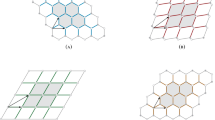Abstract
A yield surface is proposed that can be fit to the plastic flow properties of a broad class of solids which exhibit plastic compressibility and different yield points in tension and compression. The yield surface is proposed to describe cellular solids, including foamed metals, and designed to be fit to three simple experimental results: (1) the compressive stress-strain response (including densification), (2) the difference between the tensile and compressive yield points and (3) the degree of compressibility of the foam, as measured by the lateral expansion during a uniaxial compression test. The model is implemented using finite elements and used to study the effects of plastic compressibility on two problems: the compression of a doubly notched specimen and indentation by a spherical indenter.
Similar content being viewed by others
References
A. G. Evans, J. W. Hutchinson, and M. F. Ashby. to appear in Acta Mat., 1998.
L. J. Gibson and M. F. Ashby. Cellular Solids: Structure and Properties.Cambridge University Press, Cambridge, 2nd edition, 1997.
Y. Sugimura, J. Meyer, H. Bart-Smith, J. Grenstedt, and A. G. Evans. Acta Mat., 45 (12): 5245–5259, 1997.
O. Prakash, H. Sang, and J. D. Embury. Mat. Sci. Engng., A199: 195–203, 1995.
D. J. Sypeck, H. N. G. Wadley, H. Bart-Smith, S. Koehler, and A. G. Evans. Review of Progress in Quantitative Nondestructive Evaluation, 17, 1998.
P. H. Thornton and C. L. Magee. Metallurgical Trans. A, 6: 1801–1807, 1975.
M. C. Shaw and T. Sata. Int. J. Mech. Sci., 8: 469–478, 1966.
T. C. Triantafillou, J. Zhang, T. L. Shercliff, L. J. Gibson, and M. F. Ashby. Int. J. Mech. Sci., 31 (9): 665–678, 1989.
E. Andrews and L. J. Gibson. unpublished results.
G. Gioux and L. J. Gibson. unpublished results.
T. McCormack and L. J. Gibson unpublished results.
L. J. Gibson, M. F. Ashby, J. Zhang, and T. C. Triantafillou. Int. J. Mech. Sci., 31 (9): 635–663, 1989.
L. M. Kachanov. Foundations of the Theory of Plasticity.North-Holland, Amsterdam, 1971.
D. C. Drucker and W. Prager Q. Appl. Math., 10: 157–165, 1952.
R. E. Miller. unpublished.
D. Tabor. The Hardness of Metals. Clarendon Press, Oxford, 1951.
S. Biwa and B. Storhkers. J. Mech. Phys. Sol., 43 (8): 1303–1333, 1995.
M. Wilsea, K. L. Johnson, and M. F. Ashby. Int. J. Mech. Sci., 17: 457–460, 1975.
Author information
Authors and Affiliations
Rights and permissions
About this article
Cite this article
Miller, R.E., Hutchinson, J.W. A Continuum Plasticity Model for the Constitutive Behaviour of Foamed Metals. MRS Online Proceedings Library 521, 39–44 (1998). https://doi.org/10.1557/PROC-521-39
Published:
Issue Date:
DOI: https://doi.org/10.1557/PROC-521-39




